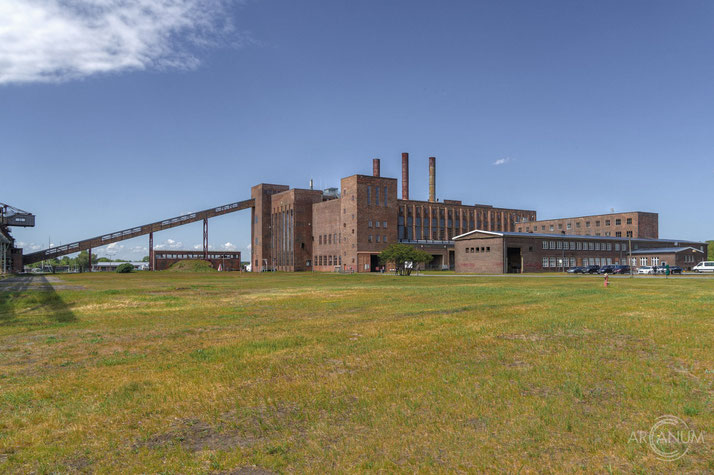Peenemünde Power Station
The Peenemünde power plant is a decommissioned coal-fired power plant on the island of Usedom in the state of Mecklenburg- Western Pomerania. It was built in the early 1940s to supply energy to the Peenemünde military testing facility and was in operation until 1990. The power station, which has been designated as an architectural monument, is almost completely preserved with its conveyor systems and is the largest industrial monument in the state.
The power station was built under the project name "KWP 327" on behalf of
the army administration by the power plant construction department of Siemens-Schuckert AG, which supplied the entire technical equipment, near the previously expanded Peenemünde main harbor.
Construction officially began on December 6, 1939, but in practice work only started after the end of the frost period in spring 1940. Originally, two identical power plants with a total output of 55 megawatts each were planned, but only one of them was built. Due to its proximity to the Peene River, an efficient coal supply could be achieved directly from the ships moored in the harbor. The coaling plant included a 200 m long crane runway built by MAN as a riveted steel construction, below which was the crusher house for crushing the coal. From the crusher house, the coal was transported by conveyor belts in an inclined elevator to the coal bunkers.
The power station building is a typical industrial building of National Socialist architecture. The proportions and design suggest Hans Hertlein as the architect or a designer who was inspired by Hertlein's buildings for Siemens in Berlin. The building was erected on an irregular ground plan on reinforced concrete piles as a three-and-a-half storey reinforced concrete skeleton structure and then clad in brick. The southern part is stepped in height and alignment. The façades of the machine house are structured by pilaster strips and ribbon windows. There is a tower-like extension at the south-east corner. A wing was added at right angles to the north-east corner, which houses a monumental staircase. The power station had been connected to the Zinnowitz-Peenemünde railroad line since 1940.
The boiler house contained four Babcock steam boilers with traveling grate firing. Each boiler had a coal bunker for 200 tons of hard coal. The steam turbines in the engine house had a total output of 30 megawatts. The cooling and process water, which was taken from the harbor basin, was cleaned in a sieve house. The heated cooling water was fed back into the harbor, allowing the harbor entrance to be kept ice-free in winter. A large proportion of the waste heat was used to operate a district heating system for the Peenemünde experimental plant, which extended as far as the Peenemünde II housing estate (now Karlshagen).
The switchgear and the cable floor as well as the management offices were housed in an extension, the switch house. The actual control room was located separately from the power station in a bunker-like building, which offered the staff protection in the event of an air raid. The power plant's own electrical systems, the 15 kV cable network, the Kröslin submarine cable, the remote control system and the telephone exchange were installed here.
The 15 kV system became operational on June 1, 1942. The official trial operation began at the beginning of August after the official handover on July 15, 1942. Regular power plant operation began in November 1942. Of the electrical output produced by the power plant, which is stated as 30 to 33 MW, around 22 MW went to the oxygen plant, where liquid oxygen was produced at great technical expense to power the A4 rockets developed and tested in Peenemünde.
After the occupation of Peenemünde by the Red Army, the power plant continued to operate. The workforce under plant manager Walter Petzold had decided against the demolition ordered by the last Peenemünde military commander, for which explosive charges had already been prepared. By August 1945, a complete machine set with boiler system and high and low-voltage switchgear had been removed and transported away as reparations. The 50 percent dismantling agreed with the Soviet authorities was not adhered to by the Soviets. In October 1945, the plant engineer Walter Petzold had to warn against further dismantling, as otherwise it would not have been possible to operate the plant, which supplied electricity not only to the Soviet troops stationed on Usedom but also to the town of Wolgast. In the early 1950s, the plant was renovated and extended and another eastern wing was added to the northern wing as a gabled two-storey brick building. Until the end of March 1990, the Peenemünde power plant supplied electricity to the GDR grid (power generation was shut down on April 1, 1990) and then produced heat for the Peenemünde naval base until 1991.
After the final decommissioning, an exhibition on the history of the site was set up in the power plant with the support of the municipality, which formed the foundation for the Peenemünde Historical-Technical Information Center (HTI), from which today's Peenemünde Historical-Technical Museum (HTM) grew. The state of Mecklenburg-Vorpommern has been involved since 2010. Between December 2010 and January 2012, extensive safeguarding, conservation and repair work was carried out on the buildings and technical facilities, which was financed with 3 million euros from the German government's second economic stimulus package. On April 27, 2012, the permanent exhibition "The power plant - built for eternity... ?" was opened on an area of 1000 m2.
Source: Wikipedia
Visited: June 7, 2020
Location: Peenemünde, Germany
Status: Museum




















































